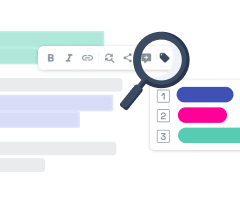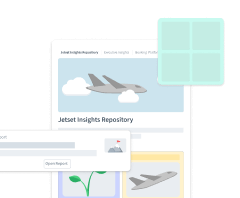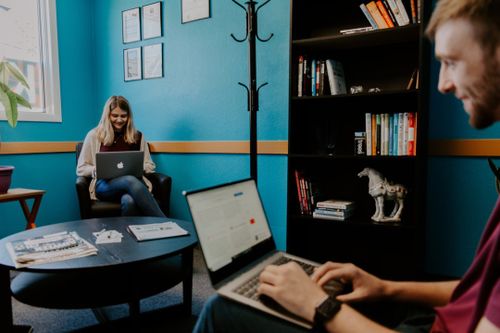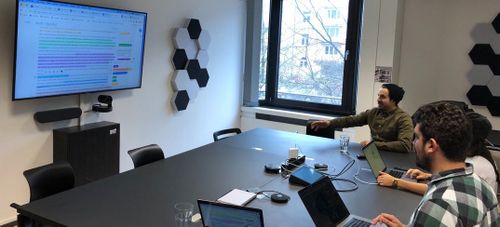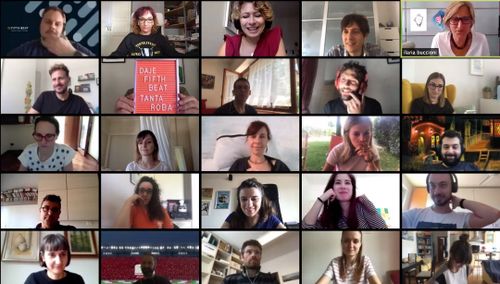
Research is a Team Sport: 12 Ideas on How to Involve Stakeholders in a UX Research Project
Approaching research as a team sport can form an entirely new relationship between UX research and your stakeholders. It’s your chance to get research insights seen, enhanced, trusted, and included in stakeholders’ decision-making. And therefore, it’s your chance to boost the impact of user research. Involving stakeholders in the research process creates a feeling of ownership and will help to prevent ignored or rejected research insights due to the “Not-Invented-Here” syndrome. While researchers often know about the positive effects of engaging stakeholders, the question of how to go about it is not as easy to answer.
This article follows the stages of a research project, covering how and when UX researchers can involve stakeholders in a meaningful way that values their time and effort. (And in the last paragraph, we change the perspective and look at some examples of where better not to involve stakeholders.)
💡Input, thoughts, and additions are highly welcome as this selected compilation lives from the practical experience, and we want to let it grow and deepen together.
Preparing a research project 📝
Joint Kick-Off: Get stakeholders on board right at the start, and get their input on crucial cornerstones of the research project:
the research goal,
why this research gets done,
and how the organization will act upon the results.
It's your chance to get commitment from everyone on the prioritization of a research project and manage expectations around the scope. If you get confronted with huge expectations, too broad or too many research questions, guide towards a prioritization in this early stage. For example, start by asking everyone: If we could only learn about one thing with this research project, what would you want that to be?
„The collaborative approach creates consensus. We have more buy-in from colleagues when we work as a team.“

Kick-Off Workshop: Jeremy Douchet wrote a great article about a workshop-style kick-off alternative that engages everyone. It is very hands-on, so we highly recommend you check it out, especially when working with clients.
Stakeholder Interviews: Besides having a joint kick-off or workshop, one-on-one interviews with your stakeholders help you understand your stakeholders' goals and get valuable information about approaching new research projects. They are often seen as THE essential step to prepare a new research project properly.
Conducting research sessions 🕵🏼♀️🕵🏾
General Tip: Make it super easy for colleagues and stakeholders to participate. Encourage them to take part in at least 2 sessions to avoid them having only one reference for the following stages. But of course, better once than never.
Note-taking: You can ask one or more of your stakeholders to support the practical research session with note-taking. This way, they can entirely slip into that observation role and follow the session with a concrete task. In addition, it will make it easier for you to moderate the session as you can entirely focus on asking the right follow-up questions. Prepare them with some tips on note-taking and what to look out for.
Debrief: After observing a research session, ask your stakeholders to share their top 3 aha-moments. Compared to note-taking, this task is more straightforward and less work-like, so it's easier to get commitment. In addition, this can increase stakeholders’ awareness in sessions, and they might pick up on something interesting that you didn’t notice.
Co-moderation: In a more active form of involvement, stakeholders can facilitate sessions as co-moderators. We highly recommend having a researcher as the main moderator of a research session. (We don't recommend stakeholders being the main moderator since this requires research experience.) In a remote setup, a co-moderator can provide the moderator with upcoming or follow-up questions live via a separate chat, for example.
Analyzing research data 🔍
Affinity Mapping: You can re-watch a session or go through transcripts or other notes with your stakeholders. Highlight relevant parts, label interesting pieces, and start making sense of your raw data by building clusters around themes that come up in your material. Freeletics emphasizes this collaborative analysis, where researchers and stakeholders walk through interview scripts and tag interesting sections as a team.
Persona Workshop: Crafting personas together can follow the initial steps of analysis. When working and thinking through preselected data, you can start cluster insights around persona categories that you have prepared. We think it’s a good idea to start the workshop with an introduction to personas emphasizing their fictional but research-backed representation of user groups. As a researcher, you can prepare a rough draft of potential personas of interest and then collaboratively add evidence from your research data towards their goals, motivations, and needs (and more).
The Italian design agency Fifth Beat team is convinced that close collaboration also positively affects the overall findings. While the Fifth Beat team brings in the analytical methods and fresh perspective, clients contribute with their domain knowledge: „This leads to a very productive mix and new insights because we are influencing each other positively.“ Read more on how Fifth Beat involves client stakeholders in research projects:
Now what? - Workshop: Involving stakeholders in the ideation for solutions will get everyone in touch with the preselected research data. Bonus point: it broadens the perspective of your ideation process right away. If you want to engage with your stakeholders one step ahead, present research findings and let everyone vote on what to ideate on first. You may not work on the most important topics, but you have the buy-in from colleagues, which can be much more critical in the longer term.
„I put the findings of my latest study into a report deck that is a format everybody is pretty familiar with. Then I did several workshops with product managers and designers, going through the deck and talking through some product ideas that come out of the insights. That felt really actionable.“

Sharing findings 🎯
Active Presentation: When presenting research findings, instead of having stakeholders passively attend, you can involve them in the presentation - for example, by having them introduce the research participants. This will immediately make them go beyond passively engaging with research findings only. Find more tips on creating engaging user research presentations here.
Movie Night: This format helps you to really convey the emotional depth of your research sessions and can be a fun event for you and your stakeholders to dive into the research findings and engage with them. We prepared a checklist for your next movie night (remote or on-site!). Check it out! 🍿
Quiz: We love the idea of Monzo, who share research findings as a quiz. Labeled as fact or fiction, the audience has to decide which insights are accurate and which are pure imagination. This starts a conversation and gets stakeholders to think about the research results actively, and we believe it’s a great way to share findings that stick. The quiz can be done on-site using post-its & dots or in a remote setting, using quiz tools like Kahoot or similar. Alternatively, start with a ‘hypotheses dump’ where you share your research questions and collect the teams’ guesses before sharing insights that Tess Rothstein described: “Asking questions before you answer them is a fun way to remind stakeholders of what we learned.”
Find all formats of stakeholder involvement we compiled here along the ‘road’ of a research project:
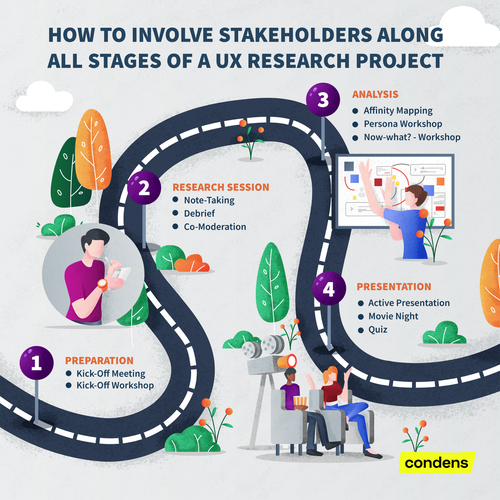
...and when better not to involve stakeholders
Engaging Stakeholders in the research leads to an increased impact of user research in general - when involving stakeholders in suitable formats, at the right time, and to the appropriate extent. Changing the perspective, here are some activities that we don't consider as necessarily well-suited for stakeholder engagement:
Choosing the proper research method
Writing interview questions or discussion guides
Crafting usability test plans & defining test scenarios
Assign stakeholders as main moderators of research sessions
Finalizing research deliverables, e.g., reports, presentation decks, or journey maps
Taking care of the legal framework, such as obtaining consent to record research sessions
Setting up & preparing a research session, either online or on-site (such as sending invitations, scheduling sessions, gathering technical equipment, booking a room)
Why not? Simple as it is, some tasks are better done solely by someone with research expertise. Focus on formats where stakeholders can immediately benefit from the engagement, e.g., by seeing real users interact with a product or speak about a personal experience. Involving stakeholders in all activities can be counterproductive when they feel that they are simply doing the work of researchers and do not see any added value to their own work.
How do you involve stakeholders in a research project?
💡Input, thoughts, and additions are highly welcome as this selected compilation lives from the practical experience, and we want to let it grow and deepen together. Reach out on LinkedIn, Twitter or send us a message to hello@condens.io.

